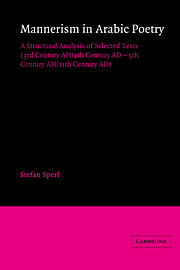 Mannerism in Arabic Poetry
Mannerism in Arabic Poetry Summary
The most conspicuous feature of Mihyār al-Daylamī's Dīwān is the length of the poems it contains: many of them have about eighty lines and some well exceed a hundred lines. On closer scrutiny, the reader will discover, interspersed between the long poems, small clusters of short pieces of verse: ‘ecphrastic epigrams’ as Biirgel calls them (see Biirgel, 1965), witty, riddle-like portrayals of disparate objects. Of these two types, it is the long poems that are of concern here. Most of them are panegyrics written in praise of the notables of the Buwayhid state. The poem which appears as text III in the appendix, is a characteristic example. It illustrates Mihyār's comprehensive style which provides the reason for the length of many of his works: the tendency to integrate all traditional topoi of court poetry in one poem. Apart from the nasīb, which includes a section on hoariness and old age, the work contains a fakhr (see Glossary), as well as a camel description and a desert journey. There are two madī sections which include passages on the mamdū's tribe, his enemies, and the duties of the Wazirate, a metaphorical description of a tribal banquet, and many lines of general praise full of historical references. It all culminates in the congratulation for the New Year festival and ends, in the vein of Mutanabbī, with a return to the fakhr theme and a laudatory section on the excellence of the poem itself.
Construction
Far from being a lengthy catalogue of themes merely connected by their conventional sequence, the work is shaped by a multitude of complex relationships.
- Type
- Chapter
- Information
- Mannerism in Arabic PoetryA Structural Analysis of Selected Texts (3rd Century AH/9th Century AD – 5th Century AH/11th Century AD), pp. 48 - 70Publisher: Cambridge University PressPrint publication year: 1989
